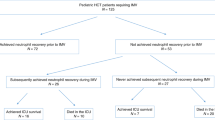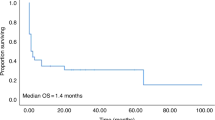Abstract
The role of support measures in the Intensive Care Unit for bone marrow transplant recipients has been controversial. Data from 176 pediatric bone marrow transplants were retrospectively analyzed to ascertain the probability, causes, risk factors and survival for life-threatening complications requiring intensive care. Ninety-two patients underwent allogeneic BMT and 84 autologous BMT between January 1991 and December 1995. Thirty-one ICU admissions were recorded. The most frequent causes were acute respiratory failure (n = 15, mostly interstitial pneumopathies), septic shock (n = 5) neurological disorders (n = 5) and heart failure (n = 2). The cumulative incidence of an ICU admission at 20 months post-transplant in patients with an allogeneic BMT was 25.7% (CI: 16.4–35.1), compared with 10.8% (CI: 4.2–17.5) in those with an autologous graft (P = 0.04). ICU admission frequency was maximum during the first 2 months post-transplant. All complications in patients with autologous transplants appeared during the first 5 months post-transplant. Among patients with allogeneic grafts, four were later admitted to the ICU, at 7, 9, 12 and 20 months post-transplant, respectively. The main risk factor for ICU admission was acute GVHD grades III–IV. No differences were found between patients with allogeneic transplants with GVHD grades 0–II and those undergoing autologous transplant. In contrast, differences were highly significant between patients undergoing allogeneic transplants with GVHD grades III–IV and those with GVHD grades 0–II or autologous transplants. No differences were observed between allogeneic and autologous transplants in terms of causes for ICU admission, duration of stay, hours on mechanical ventilation, hours on inotropic drug therapy and numbers of organs failing. Neither were differences found in ICU discharge survival between patients with allogeneic (50%, CI: 29.1–70.9) and autologous (66.7%, CI: 29.9–89.1) transplants. ICU discharge survival in patients admitted for lung disease was 28.6% (CI: 12.1–65.6) but 76.5% (CI: 41.9–87.8) in patients admitted for other causes (P = 0.007). ICU discharge survival in mechanically ventilated patients was 46.2% (CI: 27.0–65.4), significantly lower than non-ventilated patients (100%). Three-year survival in all transplanted patients admitted to the ICU was 29.7% (CI: 13.1–45.0) compared with 70.2% (CI: 62.7–77.6) in patients not requiring ICU admission (P < 0.001). although a complication requiring admission to the icu is, as confirmed by multivariate analysis, an unfavorable factor in long-term survival of transplanted patients, it must be emphasized that three of every 10 patients admitted to the icu were alive and well at 3 years. intensive care support in these patients can be life-saving.
This is a preview of subscription content, access via your institution
Access options
Subscribe to this journal
Receive 12 print issues and online access
$259.00 per year
only $21.58 per issue
Buy this article
- Purchase on Springer Link
- Instant access to full article PDF
Prices may be subject to local taxes which are calculated during checkout
Similar content being viewed by others
Author information
Authors and Affiliations
Rights and permissions
About this article
Cite this article
de Heredia, C., Moreno, A., Olivé, T. et al. Role of the intensive care unit in children undergoing bone marrow transplantation with life-threatening complications. Bone Marrow Transplant 24, 163–168 (1999). https://doi.org/10.1038/sj.bmt.1701874
Received:
Accepted:
Published:
Issue Date:
DOI: https://doi.org/10.1038/sj.bmt.1701874
Keywords
This article is cited by
-
Outcome of children requiring intensive care following haematopoietic SCT for primary immunodeficiency and other non-malignant disorders
Bone Marrow Transplantation (2012)
-
Outcome and Prognostic Factors Seen in Pediatric Oncology Patients Admitted in PICU of a Developing Country
The Indian Journal of Pediatrics (2011)
-
Transfer of the hematopoietic stem cell transplant patient to the intensive care unit: does it really matter?
Bone Marrow Transplantation (2006)
-
Supraventricular tachyarrhythmias after hematopoietic stem cell transplantation: incidence, risk factors and outcomes
Bone Marrow Transplantation (2004)



